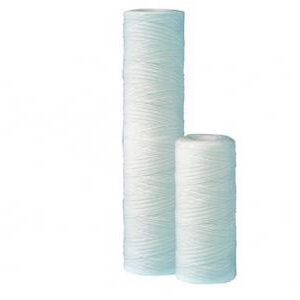Big White/Blue Carbon GAC Filter Cartridge
These Carbon filters employ a high grade carbon with industry-leading surface area allowing for the greatest efficiency of the carbon absorption.
GAC (Granular Activated Carbon) is simply carbon in the form of granules. This increases the surface area available for absorption of the unwanted chemicals within your water supply. It also extends the life of the cartridge, maximizing time between cartridge changes.
This filter cartridge is Tested and Certified by NSF International against NSF/ANSI Standard 42 for material requirements only.
Send Enquiry for Big White/Blue Carbon GAC Filter Cartridge
Description
These Carbon filters employ a high grade carbon with industry-leading surface area allowing for the greatest efficiency of the carbon absorption.
GAC (Granular Activated Carbon) is simply carbon in the form of granules. This increases the surface area available for absorption of the unwanted chemicals within your water supply. It also extends the life of the cartridge, maximizing time between cartridge changes.
This filter cartridge is Tested and Certified by NSF International against NSF/ANSI Standard 42 for material requirements only.
Application
These cartridges are compatible within whole house/high flow filter systems. These filter systems are designed to remove contaminants from the entire water supply to your home – providing near pure water to all the faucets/showers in the residence.
The micron rating of a filter cartridge determines the ability of the filter’s media to remove contaminants by the size of particles it is exposed to. For example, a filter that is marked or rated “20 micron” has some capability to capture particles as small as 20 micrometers. Although, the micron rating does not determine the exact efficiency of contaminant holding capability of the filter, it will help you det
Carbon filtering is a method of filtering that uses activated carbon to remove contaminants and impurities, taste and odour using chemical adsorption.
Each granule of carbon provides a large surface area structure, allowing contaminants the greatest possible exposure to the active sites within the filter media. One pound (450 g) of activated carbon contains a surface area of approximately 100 acres (40 Hectares).
Activated carbon works via a process called adsorption, whereby pollutant molecules in the fluid to be treated are trapped inside the pore structure of the carbon . Carbon filtering is commonly used for water purification, in air purifiers and industrial gas processing. It is also used in a number of other applications, including respirator masks, the purification of sugarcane and in the recovery of precious metals, especially gold.
Active charcoal carbon filters are most effective at removing chlorine, sediment, volatile organic compounds (VOCs), taste and odour from water. They are not effective at removing minerals, salts, and dissolved inorganic compounds. Reverse Osmosis is the best filtration for dissolved compounds.
Typical particle sizes that can be removed by carbon filters range from 0.5 to 50 micrometres. However, the amount and quality of carbon is also very important factor. The particle size will be used as part of the filter description. The efficacy of a carbon filter is also based upon the flow rate regulation. When the water is allowed to flow through the filter at a slower rate, the contaminants are exposed to the filter media for a longer amount of time.
There are 2 predominant types of carbon filters used in the filtration industry: powdered block filters and granular activated filters. In general, carbon block filters are more effective at removing a larger number of contaminants, based upon the increased surface area of carbon. Many carbon filters also use secondary media such as silver to prevent bacteria growth within the filter. Alternatively, the activated carbon itself may be impregnated with silver to provide this bacteriostatic property.
Determine which filter is most suitable according to your water supply.
Specifications
| Image | Application | Micron ratings | Size |
|---|---|---|---|
 |
Small Whole House /High Flow |
5, 10, 20 | 4.5” x 10” |
Be the first to review “Big White/Blue Carbon GAC Filter Cartridge” Cancel reply
Related products
Service and Maintenance. Water Filter replacements. Water Cooler cleaning. Repairs, installations and regular maintenance schedules. Reverse osmosis service and repairs. Zip, Supatap, Waterworks, Aqua one, All the big brands and more….
Second to none ceramics technology expertise from Doulton. The Doulton Ultracarb is a three stage cartridge combining the highly efficient filtration properties of ceramic with the enhanced water treatment properties of activated carbon and the heavy metal reduction capabilities of ion exchange media.
Ideal as a pre-filter within a twin whole house/high flow system. A String Wound filter cartridge is manufactured from surfactant-free polypropylene string over a polypropylene core. The large void volume design offers low-cost, reliable filtration performance with high contaminant holding capacity.
Polyspun sediment filters are a very effective way of removing dirt, rust, algae and other suspended contaminants from the water.
The Granulated Activated Carbon cleans and clears the water absorbing any chemicals such as chlorine or odour and makes the water taste great.
The Q-Series is the ultimate “user friendly” inline filter on the market. As with all Omnipure filters, the Q-Series is ideal for use in any situation where better tasting, sediment-free water is required - beverage equipment, RO systems, drinking fountains, ice machines, and other point-of-use applications.












Reviews
There are no reviews yet.